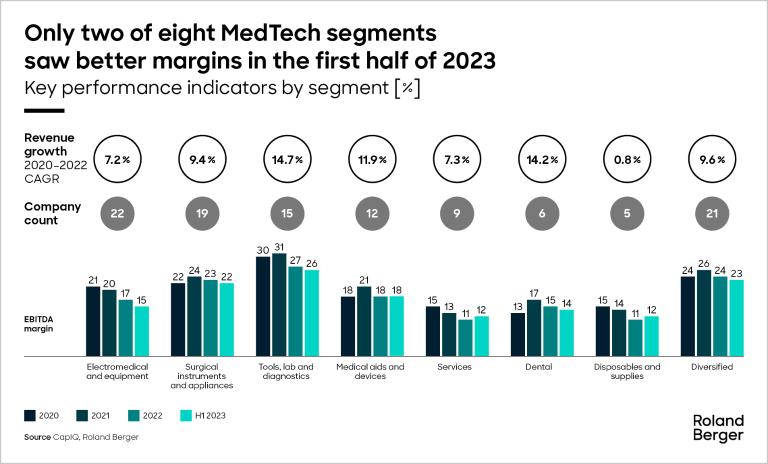Unveiling pharma industry winners! Roland Berger's Global Pharma Study 2023 reveals key traits shared by high-growth, high-profit companies.




By Thilo Kaltenbach and Marco Bühren
The MedTech industry – which makes products as diverse as diagnostic testing tools, imaging equipment, surgical devices and medical disposables – saw profitability slide in 2022 and 2023. German and other European companies took the biggest hit as geopolitical shocks threw supply chains into turmoil and pushed energy and raw-material prices higher – and the resulting inflation in turn put upward pressure on wages. To stop profits sliding ever further, companies have to embrace operational excellence in the short term and environmental, social and governance (ESG) performance as a “license to operate” over the longer term. MedTech “winners” demonstrate business leadership, strategic coherence, ability to execute, and an appropriate size and financial position.

The MedTech industry saw EBITDA margins drop three percentage points in 2022. As the world finally got a grip on the COVID-19 pandemic, this sharp dip was the result of geopolitically induced energy and raw-material price increases and inflation-driven salary rises. While companies tried to pass on higher production costs to customers, most did not manage to do so fully. Cost increases after Russia’s attack on Ukraine eroded the profits of companies headquartered in Europe more than those of companies based in the US or Asia/Pacific. As a result, the profitability gap between European companies and others widened further. European EBITDA margins averaged 17% of sales in 2022, seven points behind those of US companies and three points worse than the prior year.
Roland Berger’s MedTech Winners Analysis shows how some companies still managed to grow both revenues and profits strongly from 2019 to 2022. Our clear and robust performance indicators set them apart from “value generators”, “profitless growers” and “underperformers”. While the companies in the study sample are rather diverse in terms of product portfolio and service offerings, our analysis shows that winners share crucial characteristics that should define best practice in the industry. Tools, lab and diagnostics players as well as companies based in Asia had the highest share of high-profit and high-revenue-growth winners. Companies headquartered in Germany have the highest relative share of underperformers – although a number of MedTechs based in Europe’s largest economy still turned in winning performances.

Our analysis of selected financial data and operating figures highlights strategic imperatives common to winners. They strengthen their competitiveness by striving for continuous and above-market-revenue growth through focused innovation, strategically coherent investments and best-in-class cost structures. Among other stand-out factors, they have stable and experienced management teams, a stable financial position to secure capital comparatively cheaply, better control of the development of cost of goods sold (COGS), more efficient use of working capital, and environmental, social and governance (ESG) measures in place that significantly lower ESG-related risks. Winners show that companies can set themselves above broad industry trends – even in these extremely challenging times.
Looking into 2024, MedTech market conditions are expected to remain challenging. While reaching for operational excellence in the short term, MedTech companies need to set the agenda for ESG success, developing critical ambition levels for each of the three dimensions and conceiving concrete measures.
Register now to access the full study on Global Medtech 2023. Additionally, you get regular insights into Pharma & Healthcare topics.